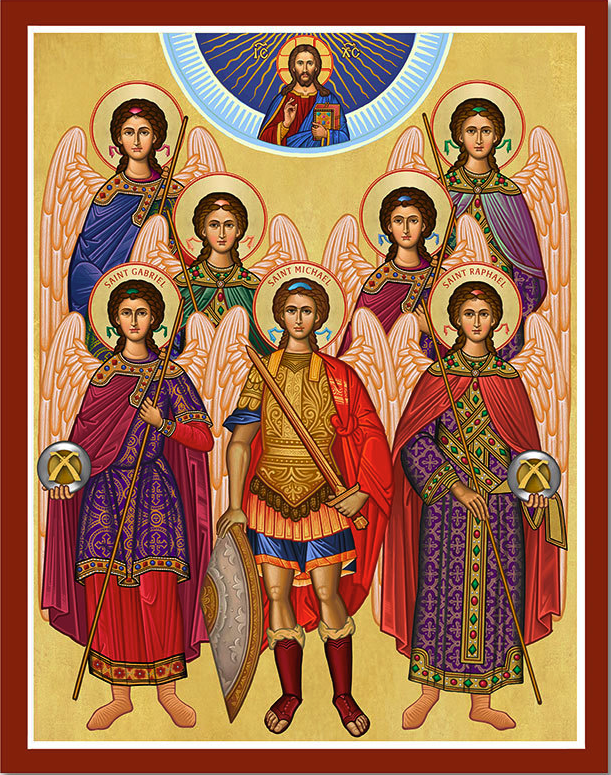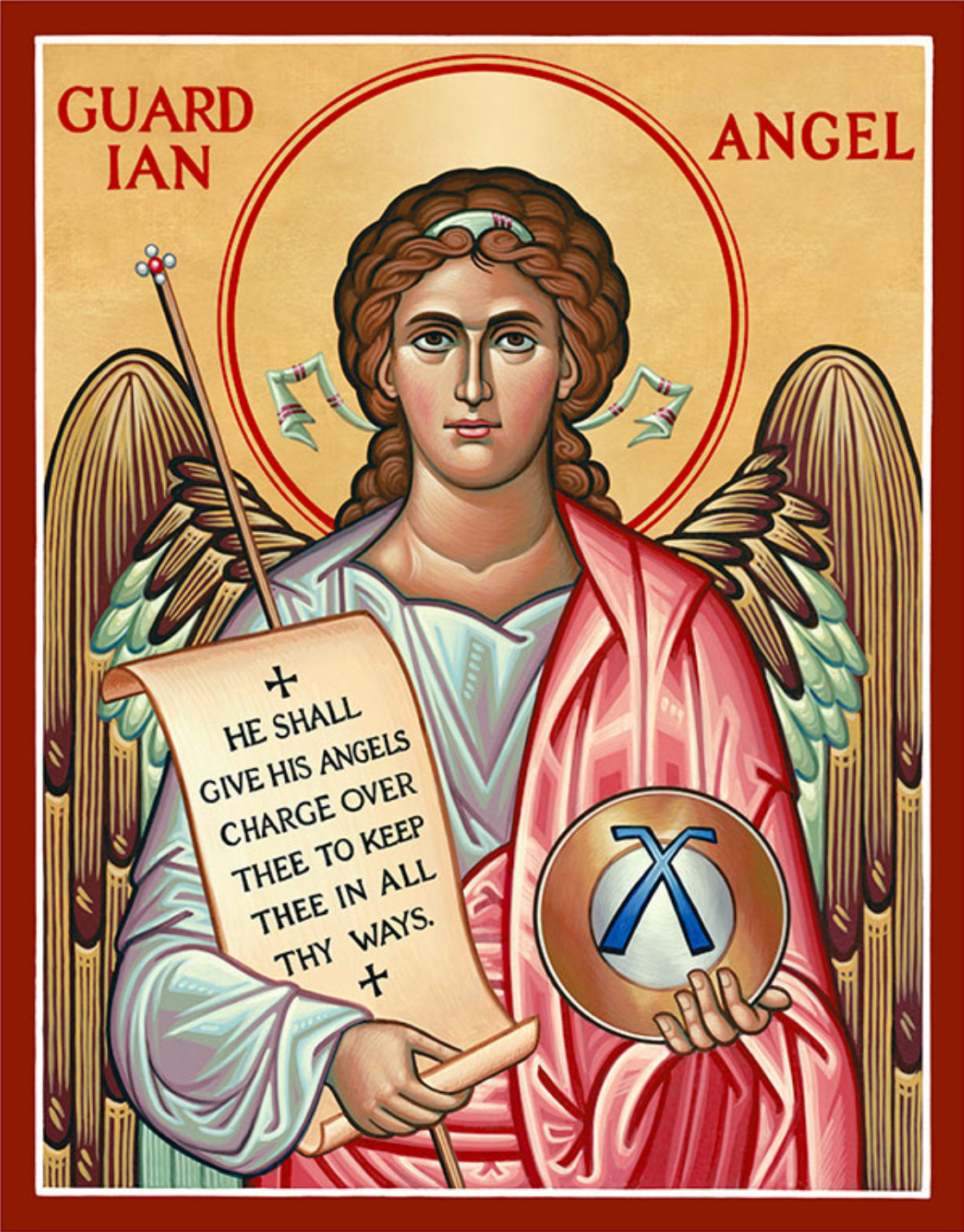Perhaps the most vivid image of an angel is that on the German postcard from 1900, the one with the larger-than-life guardian angel hovering over two barefoot children crossing a bridge with no rail and a missing plank. The boy looks ahead in terror; the girl clutches a basket with one arm and the boy’s shoulders with the other. They brave an impossibly grave storm. But the guardian angel looks on serenely, surrounding them with light and ensuring their safe passage. There is a tiny star above her head.
The existence of angels
It is comforting to think we have a guide through life’s broken bridges. But it’s more than merely a comforting thought: although the painting looks surreal, this is not folklore. The Church, following Scripture and Tradition, teaches that angels indeed exist (CCC 328). Furthermore, citing St. Basil the Great from the fourth century, the Catechism assures us, “Beside each believer stands an angel as protector and shepherd leading him to life” (CCC 336).
Reason also compels us to accept the existence of angels. In his book Angels and Us, the self-described “pagan philosopher” Mortimer Adler says we have a philosophical obligation to ponder whether minds without bodies are possible. We can deny their existence only if materialism is true, but this requires us to deny our own minds. If nothing exists but the material realm, then we are nothing but matter, and we are left with no explanation for intellect and free will.
Likewise, St. Thomas Aquinas says in his Treatise on the Angels that there must be purely spiritual creatures. God produces creatures by his intellect and will. Therefore, “the perfection of the universe requires that there should be intellectual creatures” (I.50.1, I.14.8, I.19.4). Since God is not material, the soul, with the power of intellect and will, is not material. The Angelic Doctor makes the distinction between corporeal (material) and incorporeal (spiritual) creatures in the hierarchy of creation. Animals are wholly corporeal. Humans are composite—both corporeal and spiritual. Logically, there must also be purely spiritual creatures.
The imagination
St. Thomas also says that angelic minds are higher than human minds because intellect is above sensory perception. Imagination aids our thought processes. We need images that correspond to the world we see and touch, whereas angelic thought, unencumbered by bodies, needs no such props.
Their purely spiritual nature also means that angels are difficult for us to imagine. Art provides a model for us to appreciate angels, akin to the way chemists draw atoms as round spheres held together by sticks to show how chemical reactions proceed. But just as we know atoms do not actually look like balls, we know angels are not bright and flowing beautiful women who float in the air. Images can mislead, which brings me to the subject of light.

-please click on the image for greater detail
The light of the Word
Scripture refers to angels as light (2 Cor. 11:14). Art depicts them as glowing. It is, therefore, tempting to think of angels as pure energy. (Conversely, in quantum physics, photons and electrons with their mysterious wave-particle duality seem almost to transcend physics into a spiritual realm. But this is not so, and any scientist knows it.) But energy is a property transferred to objects to do work. Energy depends on matter; hence it belongs strictly to the physical realm.
When theologians refer to angels as light, then, they do not use the word in the same sense as it is used in physics. This kind of light is not energy.
In The City of God, St. Augustine interprets the first words in Genesis, “In the beginning, God created the heavens and the earth,” to mean that two realms were created, two cities, first the one of heaven and then the one of the earth (XI, 7).
The first three days of creation when the “earth was without form and void, and darkness was upon the face of the deep” passed without sunlight. The light that kindled the sun, and separates day and night, originated from beyond our senses. This light was first made by God’s command in the holy and eternal city, the City of God.
Augustine calls this holy light the “unchangeable Wisdom of God,” by which all things are made, and whom we call the only-begotten Son of God. Augustine places the creation of the angels on the first day (XI, 9) because they had to be created before the earth was created, and they populated the City of God. The angels were illuminated by the true light that created them, the light that St. John speaks of in the beginning of his Gospel: “In the beginning was the Word,” the light that then created everything else, the same light that became man to redeem humanity.
And it all fits together
So, when God said, “Let there be light; and there was light,” there was a progression from the holy light of eternal wisdom that first shone upon the angels to the energy light in the universe. This is one of many areas where angelology gets exciting.
Modern cosmology does not contradict Augustine’s interpretation of Genesis, but the connection is more than that. The creation of angels integrates with modern science in general. Empirical investigation requires that the universe be understood as Christianity describes it, as an ordered creation. The scientific method depends on repeatable, systematic laws of physics. Scientific theories are established on the confidence that in the beginning was the Word of God.
The scientific method is also uniquely human. It relies on human intellect, the human person created in the image and likeness of God, an intelligent soul united with a sensory body. What is the first step of the scientific method? To observe. What do we do next? We design tests, analyze data, and form conclusions—all exercises that require us to take sensory input and process it abstractly in our minds.
This is why apes do not publish scientific journals. This is why angels, unlike Heisenberg and the rest of humanity, may have no uncertainty whatsoever about the whereabouts of photons and electrons. But I digress. Perhaps you understand my excitement, though. A guardian angel can be a most valuable friend to a scientist if God wills specific knowledge of nature to be gained.
For as surely as photons of light stream down from the beginning of time to provide the energy that sustains life on Earth, our guardian angels join us from all eternity to illuminate life’s journey with the light of Christ, past all danger to the City of God, if we but seek it.
Praise the Lord from the heavens,
praise Him in the heights.
Praise Him, all His angels;
praise Him, all His hosts.
Praise Him, sun and moon;
praise Him, all you stars of light.
-Ps. 148:1-3”
Love,
Matthew








